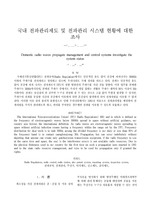Ⅰ. 서 론
희소성을 가진 전파자원은 혼․간섭 등 이용 상의 부작용을 방지하기 위해 행정주체인 미래창조과학부에 의해 관리·통제되는 공물에 해당되며 공물을 이용하는 무선국은 누구나 자유롭게 개설할 수 있는 것이 아니다. 무선국을 개설하려는 자는 전파법 제19조 제1항에 따라 원칙적으로 대통령령으로 정하는 바에 따라 미래부의 허가를 득하여야한다. 다만 실질적으로 허가가 곤란하거나 당해 기기의 기술기준 등을 통한 방법으로 이미 허가에 준하는 심사절차를 거친 경우 또는 허가를 통한 관리의 실익이 없는 경우 등에는 허가 이외의 절차를 통해서도 무선국을 개설 가능하다. 현행 전파법은 무선국 개설 허가의 신청, 허가 신청의 단위, 허가의 심사기준, 허가증의 발급, 무선국의 고시 등 무선국 개설 시 거쳐야 할 절차에 관하여 규정하고 있는데 이는 행정주체가 무선국 운영을 효율적으로 관리, 통제하기 위한 수단으로서의 성격을 가진다고 해석할 수 있다.
Ⅱ. 국내 전파관리제도
2.1. 국내전파 관리 제도
전파관리 기관 간 업무연계로 효율적인 전파관리를 위해 그림 1과 같이 전파관리 기관간 업무가 연계되어 있다.
1990년대 이후 전파수요가 급증하고 전파이용이 확대되었으며, 전파관리 정책의 패러다임이 변화됨에 따라 국내의 전파이용 규제 및 법제도에서도 많은 변화가 있었다. 다양한 전파이용 기술이 제도적으로 도입됨으로써 관련 이용기술에 따른 무선업무 및 무선국종이 재편되었고, 무선국 허가 및 신고 관련 체계에 많은 변화가 일어났다. 특히, 국내 전파법이 전면 개정된 2000년에는 551,111국개였던 무선국의 수가 2010년에는 1,166,618국, 2014년 말에는 1,609,155로 3배 이상 증가되는 등 많은 수의 무선국이 무선국 개설 허가 및 신고 등을 통하여 운영되고 있는 실정이다.
2014년 무선국의 현황을 살펴보면 이동통신 서비스가 최초 AMPS, PCS, WCDMA, LTE 등으로 진화하고 가입자 또한 급격히 증가하면서 현재 이동통신 역무용 기지국이 국내 무선국에서 차지하는 비중이 가장 크다.
· J. Lee, K. Jeong, G. Park, and K. Sohn, “A Quantitative Reliability Analysis of FPGA-based Controller for applying to Nuclear Instrumentation and Control System,” J. of the Korea Institute of Electronic Communication Sciences, vol. 9, no. 10, 2014, pp. 1117-1123.
· K. Sung and T. Poggio, “Example-based learning for view-based human face detection,” IEEE Trans. Pattern Analysis and Machine Intelligence, vol. 20 issue 1, Jan. 2008, pp. 39-51.
· T. Yamaguchi, M.Tominage, K, Mrakami, and H. Koshimizu, “Regeneration of facial image eye-contacting with partner on TV Confernce environment,” IEEE Int. Conf. on Systems, Man, and Cybernetics, Chicago, USA, Sept. 2006, pp. 1169-1174.
· M. Faruqe and M. Hasan, “Face Recognition Using PCA and SVM,“ Anti-counterfeiting, Security, and Identification in Communication, 2009. ASID 2009. 3rd Int. Conf. on, Hong Kong, Aug. 2009, pp. 97-101.
· J. Yang and J. Yang, “Why can LDA be performed in PCA transformed space?,” Pattern Recognition, vol. 36, no. 2, Feb. 2003, pp. 563-566.
· V. Napnik, The Natue of Statistical Learning Theory. New York: Springer-verlag, 1995.
· P. Liao, J. Liu, M. Wang, J. Ma, and W. Zhang, “Ensemble local fractional LDA for Face Recognition,” Computer Science and Automation Engineering(CSAE), 2012 IEEE Int. Conf. on, Zhangjiajie, China, vol. 3, May 2012, pp. 586-590.
· C. Liu and H. Wechsler, “Independent component analysis of Gabor feature for face recognition,” IEEE Trans. Neural Networks, vol. 14, no. 4, July 2003, pp. 919-928.
· S. El-Khamy, O. Alim, and M. Saii, “Neural Network Face Recognition Using Statistical Feature Extraction,” Radio Science Conf., 2000. 17th NRSC '2000. Seventeenth National, Brisbane, Australia, Feb. 2000, pp. C31/1-C31/8.
· E. Osuna, R. Freund, and F. Girosi, “Training Support Vector Machines: An application ot face detection,” Proc. IEEE. Computer Society Conf. on. Computer Vision and Pattern Recognition(CVPR), San Juan, Puerto Reco. June 1997, pp. 130-136.
· M. Yang, “Kernel Eigenfaces vs, Kernal Fisherfaces: Face Recognition Using kernal Methods, Automatrix Face and Gesture Recognition,” 202, Proc. Fourth IEEE Int. Conf., Washinton D.C., USA, May 2002.
· H. Kim, “Vocal Separation in Music Using SVM and Selective Frequency Subtraction,” J. of the Korea Institute of Electronic Communication Sciences, vol. 10, no. 1, 2015, pp. 1-6.
· J. Jo, “A Car License Plate Recognition Using Colors Information, Morphological Characteristic and Neural Network,” J. of the Korea Institute of Electronic Communication Sciences, vol. 5, no. 3, 2010, pp. 304-308.
· H. Park, “A User Adaptation Method for Hand Shape Recognition Using Wrist-Mounted Camera,” J. of the Korea Institute of Electronic Communication Sciences, vol. 8, no. 6, 2013, pp. 805-814.

